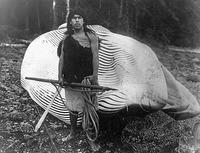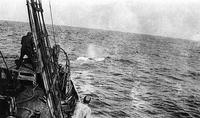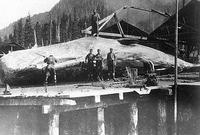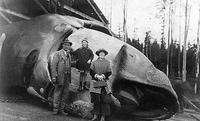Whaling
WHALING was first practised by the NUU-CHAH-NULTH people on the west coast of VANCOUVER ISLAND, long before the arrival of Europeans. The Nuu-chah-nulth pursued the WHALES as they migrated along the coast. Hunters went to sea in log CANOES, armed with harpoons tipped with blades of MUSSEL shell. A long line of CEDAR bark and sinew trailed behind the harpoon, dragging several sealskin floats to tire the fleeing animal. Once the kill was made, the carcass was towed back to the village and butchered. Cloaked in elaborate ritual and festivity, whaling played an important role in Nuu-chah-nulth culture. In 1998 the Nuu-chah-nulth served notice that like their Makah relatives in Washington state, they were contemplating a resumption of the hunt, targeting the gray whales that migrate past the coast each year.
Commercial whaling began in the 1830s when American and European ships began killing whales on the "Northwest Ground" off the Pacific Coast. A shore-based industry was attempted at stations in GEORGIA STRAIT and on Vancouver Island from 1866 to 1872, but failed. It was not until 1905 that modern shore whaling came to the coast. Using exploding harpoons and speedy catcher boats, whalers hunted the animals offshore, then towed them to the shore stations. Pacific Whaling Co (PWC) operated stations on the west coast of Vancouver Island (SECHART and KYUQUOT SOUND) and on the QUEEN CHARLOTTE ISLANDS (NADEN HARBOUR and ROSE HARBOUR) until 1943. In 1948 PWC was replaced by the Western Whaling Co in COAL HARBOUR, QUATSINO SOUND. It produced whale meat principally for export to Japan and stayed in business until 1967, when commercial whaling on the coast ended. The federal government officially halted the hunt in 1972, by which time the only stations in operation in Canada were on the Atlantic coast.
-
-
Internet links





